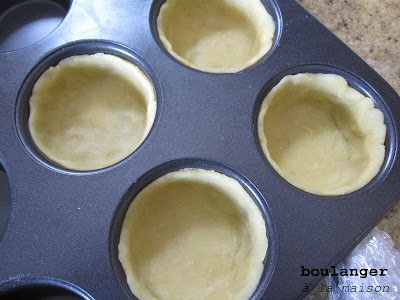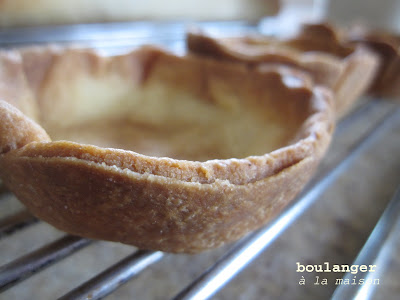Green tea ice cream with red bean paste is a classic Japanese dessert (and one of the best). Most of Japanese restaurants back in my home town (Bangkok, Thailand) would have it on their menu. I am a big fan of them. It is the dessert that I love so much. Back home (well, I don't live in Thailand anymore), green tea is very popular as being a super food. It is rich in vitamin C and has a distinctive flavour. Somehow, green tea and red bean also makes me feel nostalgic. It reminds me of the similar dessert or drink I had when I was living in Thailand.
I came across green tea powder (matcha powder) at Fuji Japanese supermarket in Prahran, Melbourne. Immediately, I was thinking "perfect, I can make green tea ice cream with this". In the past, I just mixed the green tea powder through store-bought vanilla ice cream and voila...green tea ice cream. I served them with home-made red bean paste (I don't like store-bought one as it is way way too sweet) quite a few times at dinner party (also as my own treats). That was before I got into cooking/making things from scratch. Thanks to the discover of my passion for bread-making.
"Green tea powder, it comes in a small tub, approximately 6-cm height. It costs around AUD$7"
Nowadays, I made green tea ice cream from scratch. They are truly smoother and taste so much nicer than the ones I made using vanilla ice cream. And they are not difficult to make. The result will worth your effort.
Before I bought the Cuisinart ice cream maker, I had to churn the ice cream manaully. It worked and it tasted alright. But after I made the ice cream using ice cream maker... really, why wouldn't I buy it sooner? The ice cream texture is significantly different and took much less time and effort using the machine. This is one of the gadget I am most happy with...money well spent and will be perfect for the upcoming Summer season.
"My new toy, Cuisinart ice cream maker. I have so much fun playing with it. It's so easy to use and produce great result with little effort."
One of the reason that I'm into making ice cream lately is because I have so many left-over egg yolks from making macarons. They're so many rich, custard-like brioche I can make and eat, and the same go with creme brulee...I had to find other avenue to use the yolks. Ice cream is the answer!
There are few different ways you can make ice creams, with egg yolks, without egg yolks, with less cream, with more creams. Personally, I prefer ice cream made with egg yolks, and the equal amount of milk & cream (thickened cream/whipping cream). It is simply smoother, creamier and just plain nicer. The number of yolks you put in will affect the creaminess of the ice cream, the more egg yolks, the creamier the texture. No yolks at all means ice cream can become rather icy, i.e. with ice flakes.
Green tea ice cream with red bean paste recipe
Green tea ice cream
makes almost 1 litre ice cream
6 egg yolks (I have tried making it with 3 yolks and it was still creamy and tasted as nice)
250 ml (1 cup) milk
250 ml (1 cup) thickened cream (whipping cream with minimum 35% fat content)
100 g (1/2 cup) caster sugar (fine sugar)
1 tablespoon green tea powder (matcha powder)
Mix milk, cream and green tea powder in a small saucepan over medium-high heat and bring it to the boil. Stirring gently to dissolve the green tea powder. When the mixture start to boil, immediately remove the saucepan from heat.
In the meantime, beat egg yolks with caster sugar at medium-high speed unitl it is pale and creamy (the sugar will almost dissolve).
Pour the hot green tea mixture into the egg mixture and stir at low speed until well-combined.
Put the mixture back into the small sauce pan and cook it over low-medium heat. Keep stirring the mixture until it coats the back of the spoon. It will take approximately 4-5 minutes.
"Cook the mixture at the low-medium heat for 4-5 minutes"
"The mixture starts to coat the back of a spoon"
Note: I have tried skipping the ice bath and put the mixture straight into the fridge (NOT freezer) I then wait until it is completely cool down before start the ice cream churning process.
"The ice cream mixture is sitting on top of an ice bath in a bigger bowl"
Once the ice cream mixture is completely cool down. Put it into the ice cream maker and follow the instruction of the manufacturer.
Note: If you do not have an ice cream maker, I say, go and buy one now :-) Well, you can actually make an acceptable ice cream without an ice cream maker but there'll be more works, i.e. you'll need to chill the mixture in the freezer and keep taking it out and breaking it with the beater few times before the ice cream has set. This is to break the ice flakes forming.
"Ice cream is getting churned in the machine"
Red bean paste (adzuki bean paste)
make about 4 cups
1 cup red bean (adzuki bean)
1 cup sugar
3 cups water
a pinch of salt
"This is a very easy recipe. It tastes far more superior than the store-bought ones and more importantly, you can adjust the sweetness to your taste. I find the store-bought ones are way too sweet."
Wash the beans and put in a medium-size pot filled with water. Bring it to the boil over a high heat. Drain and discard the water.
Add about water to par-cooked red beans and bring to the boil over high heat.
Reduce the heat to medium, cover the pot and simmer the beans until they are soft. It will take approximately 1 - 1.5 hours. The water should be almost completely absorbed by the time the beans are soft. Add water as needed to prevent it getting too dry (I had to add one more cup of water half way through cooking).
Gently mix in sugar and pinch of salt until all combined and glossy. The paste will be thick with half and whole red beans. I like the paste to have a good mash consistency so I used the potato masher to help crushing the beans.
"The finished bean paste is quite thick and has got a little amount of liquid in them. The beans are still cooking off the heat and the liquid will completely absorbed into the paste".
Store the bean paste in a covered container in a fridge for up to a week.
Note: This bean paste can be used as filling to a sweet bread, chinese bread bun, pancake topping, or with a dallop of cream, yogurt or milk.Serve the bean paste with green tea ice cream.
Yummy!
Gone in 60 seconds....




















































